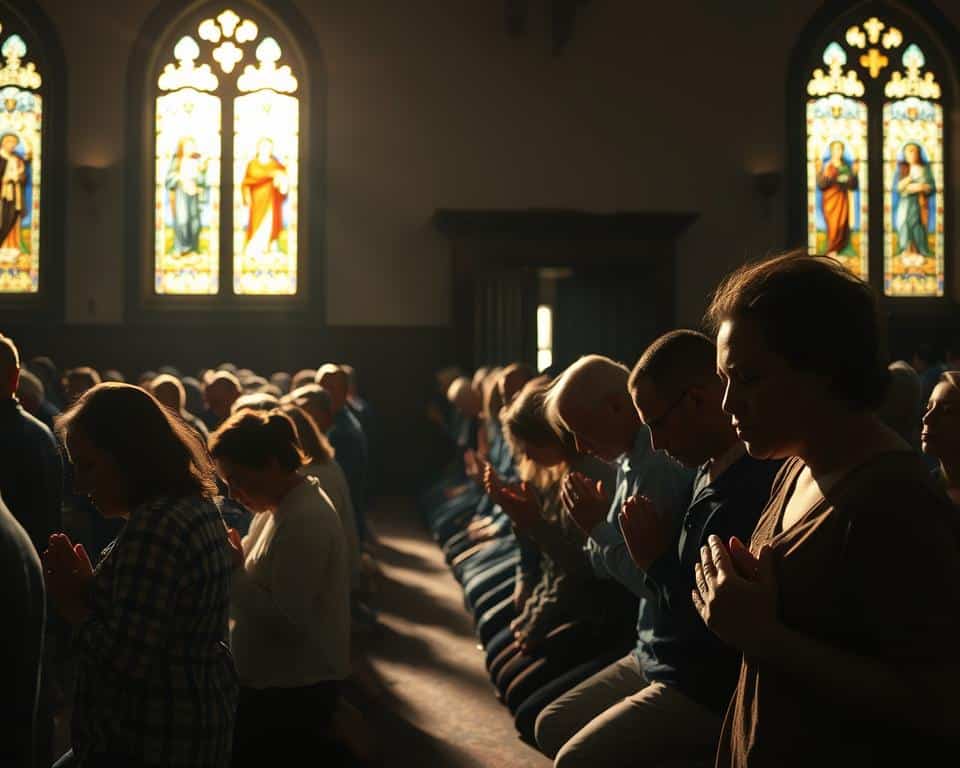“Prayer is not asking. It is a longing of the heart.” – Mahatma Gandhi’s words remind us that true connection with God goes beyond words. It’s about aligning our hearts with His presence.
In Christian faith, prayer isn’t just a request line. It’s the foundation of worship. When we lift our voices in song or recite Scripture together, we’re engaging in a form of devotion that unites believers. Paul’s instruction in 1 Thessalonians 5:16-18 makes it clear: prayer is a lifestyle, not just an event. Through prayer, we deepen our relationship with God, seeking His guidance and strength in our daily lives. This persistent communication fosters spiritual growth and instills a sense of peace, even amidst challenges. Ultimately, understanding why prayer matters in Christianity illuminates its role as a vital connection to our Creator and as a means of communal support among believers.
Think of worship choruses as musical prayers. Scripture readings become corporate declarations. Every moment spent in God’s truth strengthens our love for Him and others. This rhythm of devotion keeps our focus on what matters most. As we engage in communal worship, the lyrics of our choruses often reflect the deep truths found in the Scriptures, reminding us of God’s character and His promises. This connection highlights how scripture influences worship practices, guiding us in expressing our faith and devotion. Ultimately, these moments cultivate a deeper understanding of God’s word and its transformative power in our lives. Furthermore, the importance of hymns in worship cannot be overstated, as they connect generations through shared beliefs and experiences. These timeless melodies serve as anchors for our faith, reminding us of God’s promises and central truths. In this atmosphere of reverence and unity, we cultivate a deeper understanding of our purpose and commitment to God’s mission.
When we embrace prayer as worship, our faith grows deeper. It shifts from routine to relationship, transforming how we live each day. Let’s explore how this powerful practice shapes a life centered on Christ.
Prayer as Worship: A Direct Connection to God
Hebrews 4:16 reveals the privilege of coming before God’s throne. Through Christ, we approach with boldness—not arrogance, but a childlike trust in His grace. This sacred access transforms routine words into worship.

Biblical Foundations of Prayer in Worship
Scripture shows God’s power through answered cries. The Red Sea parted for Moses. Daniel was shielded from lions. Each miracle reflects His desire to engage with His people.
Psalms like 145:8 model praise-focused dialogue:
“The Lord is gracious and compassionate, slow to anger and rich in love.”
Such verses remind us to center our words on His character.
How Prayer Mirrors Worship Choruses and Scripture
Singing hymns is like lifting melodies to heaven. When voices unite, the church becomes a choir of surrendered hearts. Even Paul knelt in humility (Acts 20:36), showing posture matters as much as words.
Reading the Bible aloud? That’s communal worship too. Every verse declares God’s truth, anchoring us in His promises. Whether through song or Scripture, worship is our lifeline to the Divine.
Prayer Brings Us Into God’s Presence
The throne room of heaven isn’t distant—it’s accessible through faith. Hebrews 4:16 invites us to approach with boldness and reverence, a paradox that deepens our connection. Like Donald, a Zambian pastor whose prayers ignited revival, we too can experience God’s nearness.

The Role of Boldness and Awe
Confidence in Christ doesn’t erase holy fear. When Moses stood before the burning bush, he removed his sandals—a posture of humility. Yet God called him to lead with authority. Prayer mirrors this balance: we claim promises while kneeling in awe.
Try these steps to cultivate reverence:
- Pause before speaking. Let silence anchor your heart.
- Scripture guides worship. Psalms like 57 shift desperation to praise.
- Posture matters. Kneeling or open hands reflect surrender.
Throne Room Encounters in Scripture
Daniel’s lions’ den prayer (Daniel 6:22) and the Red Sea miracle (Exodus 14) reveal God’s power and mercy. These weren’t just rescues—they were divine appointments. Jesus’ resurrection, the ultimate display of glory, assures us: prayer moves heaven.
“The Lord is near to all who call on Him in truth.”
Whether in a Zambian village or your living room, prayer creates sacred space. Align your heart with His ways, and watch ordinary moments become encounters with the Divine.
Prayer Shifts Our Focus to God’s Glory
True devotion begins when our words turn heavenward. Instead of listing requests, the Psalms teach us to start with praise. Like David in Psalm 75:1, we declare, “We give thanks to You, God, for Your Name is near.” This reorients our soul from problems to His power.
Learning from the Psalms: Praise-Centered Prayer
Notice how Psalm 145:8 opens: “The Lord is gracious and compassionate.” It mirrors Jesus’ model in Matthew 6:9—honoring God’s name before asking. Try this structure:
- Adoration: Speak His attributes first.
- Thanksgiving: Recall past faithfulness.
- Request: Align needs with His will.
Even crises become worship when we follow Job’s example (Job 1:20-21). He praised amid loss, fixing his eyes on God’s glory, not his pain.
Practical Ways to Prioritize God in Prayer
1 Corinthians 10:31 reminds us: “Do all for God’s glory.” Here’s how:
- Gratitude journals: Jot three daily blessings. Watch complaints fade.
- Scripture prayers: Pray Psalm 3:3 back to God: “You, Lord, are my shield.”
- Mundane moments: Wash dishes with thanks, seeing service as worship.
“Let my mouth be filled with Your praise and with Your honor all the day.”
When we center our world on Him, even traffic jams become chances to declare His worth.
Prayer Aligns Our Hearts with God’s Will
Jesus’ agony in Gethsemane reveals the power of surrendered hearts. Facing the cross, He modeled perfect alignment: “Not as I will, but as You will” (Matthew 26:39). This moment reframes prayer from demand to devotion.
Jesus’ Example in the Garden of Gethsemane
His sweat like blood (Luke 22:44) shows the cost of surrender. Yet His submission opened the way to eternal life. Unlike crisis prayers—frantic pleas for relief—Jesus’ words honored God’s plan first.
James 4:3 warns against self-centered requests. Alignment guards our hearts from treating God like a vending machine. Instead, we echo David: “Unite my heart to fear Your name” (Psalm 86:11).
Surrendering Personal Desires for Divine Purpose
Paul’s kneeling in Acts 20:36 wasn’t just posture—it symbolized lifelong surrender. Like him, we’re called to lay down preferences daily. Isaiah 59:1-2 reminds us: sin blocks connection, but repentance restores it.
Try these phrases to cultivate surrender:
- “Your wisdom, not mine” (Proverbs 3:5-6)
- “Shape my desires to Yours” (Romans 12:2)
- “Even if You say no, I trust You” (Daniel 3:18)
“The Holy Spirit helps us pray according to God’s will.”
When we anchor in truth, our life reflects His love. Every “not my will” draws us closer to His heart.
Prayer as a Lifestyle of Worship
Every moment can become sacred when offered to God. 1 Corinthians 10:31 reshapes our perspective: “Whether you eat or drink, do all for God’s glory.” Even ordinary actions turn holy when done with a surrendered heart.
Beyond Sunday: Integrating Prayer into Daily Life
Try these simple ways to make devotion part of your rhythm:
- Mealtime gratitude: Thank God for nourishment before each bite.
- Prayer alarms: Set reminders to pause and praise at 10 AM, 3 PM, etc.
- Breath prayers: Whisper “Jesus, fill me” during stressful moments.
“Love the Lord your God with all your heart, soul, mind, and strength.”
How Small Acts Become Worship
Donald, a Zambian believer, washes dishes while singing hymns. His secret? Colossians 3:23: “Work as for the Lord.” Here’s how to follow his example:
- Chores with joy: Fold laundry as an act of service to your family.
- Commute conversations: Talk to God about coworkers while driving.
- Three-directional focus: Upward (praise), inward (reflection), outward (serving others).
When we see life as worship, even traffic jams become chances to reflect God’s love. Start small, and watch your days transform.
Living a Life of Prayer and Worship
True devotion flows when faith meets daily life. The Lord’s Prayer model (Matthew 6:9-13) guides us—first honoring God’s name, then seeking His will. This HE-WE-THEY rhythm keeps our focus on His glory, not just our needs.
Psalm 119:164 inspires seven daily praise moments. Set reminders to pause, reflect, and thank God. Avoid empty words (Matthew 15:8-9). Let your heart align with His truth.
Every whispered plea or song of thanks ignites worship. From morning coffee to evening walks, make life an offering. Grace transforms routines into sacred moments.
Challenge yourself: praise God seven times today. Kneel in awe, knowing Christ opened heaven’s throne room for you. This is worship—not just words, but a life surrendered.





